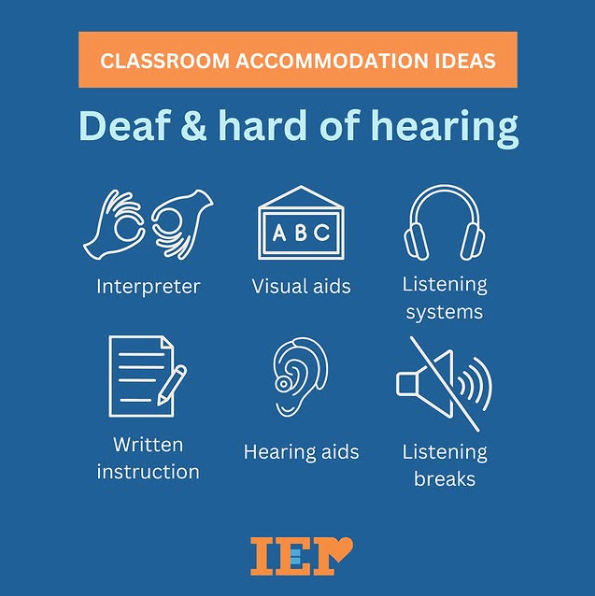Table of Contents
- What Are Accommodations?
- Classroom Accommodations
- Testing Accommodations
- Inclusive Teaching Strategies
- Workplace Accommodations
- Legal Frameworks
- International Considerations
- Q&A: Frequently Asked Questions
- Conclusion: Equal Opportunities for All
What Are Accommodations?
Accommodations are tools, services, or changes made to support individuals who are deaf or hard of hearing. They ensure equal access to communication, learning, and opportunities. Common examples include interpreters, captioning services, assistive listening devices (ALDs), and note-taking assistance.
Accommodations do not reduce academic or workplace standards but instead remove barriers that prevent equal participation. They are tailored to the individual’s specific needs, ensuring they have the tools to succeed. To learn how accommodations can be implemented in an inclusive setting, visit ADCET's Inclusive Teaching Guide.
Classroom Accommodations
For students who are deaf or hard of hearing, classrooms can be made accessible with small but meaningful adjustments.
- Priority Seating: Students should sit at the front of the classroom to see the teacher’s face clearly for lip-reading or watching an interpreter.
- Visual Aids: Use tools such as PowerPoint slides, charts, and videos with captions. Captions ensure students understand both spoken dialogue and sound effects.
- Note-Taking Assistance: Assign a trained note-taker or share lecture notes in advance so students can focus on interpreters or captions.
- Interpreters: Provide interpreters for students who use American Sign Language (ASL) or other communication methods. Ensure interpreters are positioned where they can be easily seen.
- Assistive Listening Devices (ALDs): Use ALDs like FM systems to amplify speech and reduce background noise.
These accommodations ensure students can fully engage in lessons without unnecessary stress. For detailed recommendations, see the Hands & Voices IEP Checklist.
Testing Accommodations
Testing accommodations are essential for students to succeed in assessments.
- Extended Time: Extra time allows students to process questions and responses through captions or interpreters.
- Captioned Media: Provide captions for audio or video components of tests. If unavailable, offer transcripts or live interpretation.
- Private Testing Rooms: Ensure a quiet environment free from distractions, especially for students using assistive devices.
- Scribes: Offer a scribe to write down answers dictated by the student.
- Sign Language Interpreters: Provide interpreters for instructions or test questions if requested.
The College Board Guidelines outline the process for requesting accommodations for standardized exams like the SAT and AP tests.
Inclusive Teaching Strategies
Inclusive teaching strategies make classrooms welcoming for all students, including those who are deaf or hard of hearing.
- Face the Class While Speaking: This helps students who rely on lip-reading or visual cues.
- Repeat Questions or Comments: Reiterate questions or comments made by other students to ensure everyone follows.
- Minimize Background Noise: Reduce distractions like fans, hallway chatter, or loud air conditioners.
- Manage Group Discussions: Encourage one person to speak at a time to make communication clearer.
- Provide Flexible Tools: Allow students to record lectures or provide digital copies of materials.
For additional tips, visit Baruch College's Teaching Guide.
Workplace Accommodations
In the workplace, accommodations ensure employees who are deaf or hard of hearing can succeed and communicate effectively.
- Assistive Technology: Use tools like captioned telephones, video relay services (VRS), and assistive listening devices (ALDs).
- Visual Emergency Alerts: Provide fire alarms with flashing lights to ensure safety during emergencies.
- Interpreters: Offer interpreters for meetings, training sessions, or workplace events.
- Flexible Communication: Use email or messaging apps for quick communication instead of relying on phone calls.
Employers are required by the Americans with Disabilities Act (ADA) to provide reasonable accommodations. For more details, visit the EEOC Hearing Disabilities Guidance.
Legal Frameworks
Several laws protect the rights of individuals who are deaf or hard of hearing:
- Americans with Disabilities Act (ADA): Ensures reasonable accommodations in education, employment, and public spaces.
- Section 504 of the Rehabilitation Act: Requires federally funded programs to provide equal access to individuals with disabilities.
- Individuals with Disabilities Education Act (IDEA): Mandates the creation of Individualized Education Programs (IEPs) for students with disabilities.
Proper documentation is critical when requesting accommodations. The College Board Guidelines recommend including:
- A clear diagnosis of the hearing condition.
- Recent evaluations (within two years).
- Evidence of functional limitations.
- A history of past accommodations.
International Considerations
For individuals who are deaf or hard of hearing, international travel or exchange programs require extra planning.
- Sign Language Differences: American Sign Language (ASL) is distinct from other sign languages used globally. Participants may need interpreters familiar with both ASL and the local language.
- Captioning and Speech-to-Text Services: Programs should ensure real-time captioning or transcripts are available for lectures and events.
- Compatible Technology: Assistive listening devices must work with local systems.
For more information, visit MIUSA's Deaf Accommodations Guide.
Q&A: Frequently Asked Questions
Q1: What is the difference between accommodations and modifications?
Accommodations provide equal access without changing the content or expectations of a task. Modifications, on the other hand, involve changing the task itself, such as simplifying an assignment.
Q2: How do I request accommodations for standardized tests?
Submit documentation of the student’s diagnosis and past accommodations to the College Board or the testing organization. More details can be found in the College Board Guidelines.
Q3: Are employers required to provide accommodations?
Yes, under the ADA, employers must provide reasonable accommodations unless it causes undue hardship.
Q4: How can teachers support students who are deaf or hard of hearing?
Use visual aids, provide interpreters, minimize background noise, and ensure all materials are captioned.
Q5: What are examples of assistive listening devices?
Common devices include FM systems, digital modulation systems, and induction loop systems.
Conclusion: Equal Opportunities for All
Accommodations for individuals who are deaf or hard of hearing remove barriers and create opportunities for success. Whether in the classroom, workplace, or international settings, fostering inclusion ensures everyone can thrive.
By offering interpreters, captioning, assistive listening devices, and inclusive teaching strategies, educators and employers can make a meaningful difference. For more resources, visit the National Deaf Center's Access & Accommodations Guide.


